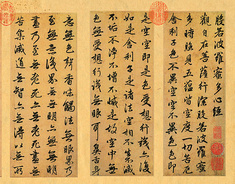
Introduction to the Heart Sutra
Last updated: Monday October 4th, 2021
Report this blog
The Heart Sutra is the most frequently used and recited sutra in Mahayana Buddhism throughout East and Central Asia. Its importance can be compared to the Lord's Prayer in Christianity.
In Sanskrit, the full title प्रज्ञापारमिताहृदय (Prajñāpāramitāhṛdaya) translates to "The Heart of the Perfection of Wisdom". The sutra was first translated into Chinese in the 5th century. But the most common version, the one below which is only 260-character long, was translated by Xuanzang during the Tang Dynasty. It was first translated into English in 1864. Nowadays there are dozens of different translations. Here I am combining many of these (such as this one, this one, and this one) to the version below which is easier to read but may not be as accurate as the original text.
The Heart of the Perfection of Wisdom
般若波羅蜜多心經
When Avalokiteshvara Bodhisattva was meditating deeply on the Perfection of Wisdom, s/he had an epiphany that the five aspects of human existence are empty, thus released him/herself from all suffering.
S/he said to Sariputra, "Form does not differ from emptiness, emptiness does not differ from form. Form is empty, emptiness is form. Feelings, perceptions, thought formations, and consciousness are all likewise."
"Sariputra! All things are empty. They are neither born or destroyed, neither tainted or pure, neither increasing or decreasing."
"So, in emptiness there is no form, no feelings, perceptions, thought formations or consciousness. No eyes, ears, nose, tongue, body or mind. No colour, sound, smell, taste, touch or thoughts."
"There is no realm of eyes, and so forth until no realm of mind consciousness. No ignorance, and no end to ignorance. So forth until there is no old age and death, and no end to old age and death."
"There is no suffering, no causes of suffering, no ending suffering, no path to ending suffering. There is no wisdom and no attainment, and no wisdom to attain."
The Bodhisattvas rely on the Perfection of Wisdom and hence their minds have no hindrance; and with no hindrance there are no fears. Staying far away from delusive dreams and thereby achieving nirvana.
All the Buddhas past, present and future rely on the Perfection of Wisdom to attain full enlightenment.
So know that the Perfection of Wisdom is the greatest mantra, the clearest mantra, the highest mantra, the unequalled mantra. It can remove all suffering. This is true and nothing but the truth.
So say the Perfection of Wisdom mantra, it goes as followed: Gaté, gaté, paragaté, parasamgaté. Bodhi! Svaha!
觀自在菩薩,行深般若波羅蜜多時,照見五蘊皆空,度一切苦厄。
舍利子!色不異空,空不異色;色即是空,空即是色,受想行識亦復如是。
舍利子!是諸法空相,不生不滅,不垢不淨,不增不減。
是故,空中無色,無受想行識;無眼耳鼻舌身意;無色聲香味觸法;
無眼界,乃至無意識界;無無明,亦無無明盡,乃至無老死,亦無老死盡;
無苦集滅道;無智亦無得,以無所得故。
菩提薩埵,依般若波羅蜜多故,心無罣礙;無罣礙故,無有恐怖,遠離顛倒夢想,究竟涅槃。
三世諸佛,依般若波羅蜜多故,得阿耨多羅三藐三菩提。
故知:般若波羅蜜多是大神咒,是大明咒,是無上咒,是無等等咒,能除一切苦,真實不虛。
故說般若波羅蜜多咒,即說咒曰:揭諦揭諦,波羅揭諦,波羅僧揭諦,菩提薩婆訶。
You may be thinking "what have I read?", "this doesn't make sense" or "this is so confusing and contradictory". But don't worry, I will try to explain very briefly what this sutra says.
Who are Avalokiteshvara and Sariputra?
First of all, there are two people mentioned in the sutra, namely Avalokiteshvara and Sariputra. Avalokiteshvara is a bodhisattva ("buddha-to-be") who is known for his/her mercy and compassion. S/he is called Guanyin in China and has evolved into a female figure venerated in East and Southeast Asia, becoming a goddess in Taoism and other folk religions.
In one prominent Buddhist story, Avalokiteshvara vowed not to rest until she saved all sentiment beings from the cycle of rebirth, but she struggled to comprehend the needs of so many unhappy beings. The buddha Amitābha, upon seeing her plight, gave her eleven heads and a thousand arms to help her hear the cries of those who are suffering and to reach out to those in need. Therefore you can find many statues of Guanyin in Asia with many heads and arms, like the one below.
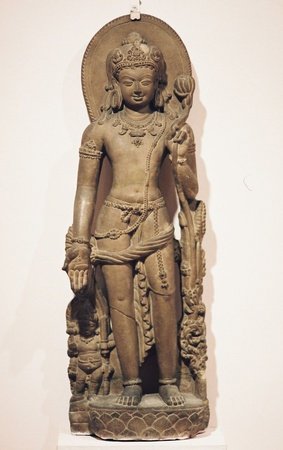
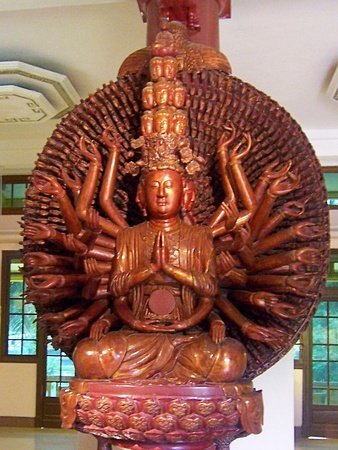
Sariputra was the first of the Buddha's two chief disciples. He followed the Buddha for over 20 years and led the group of monks. He was the first disciple of the Buddha who was asked to ordain monks in his place. He is regarded as an important and wise disciple of the Buddha, and frequently appears in many sutras as the Buddha spoke directly to him during his many Dharma talks.
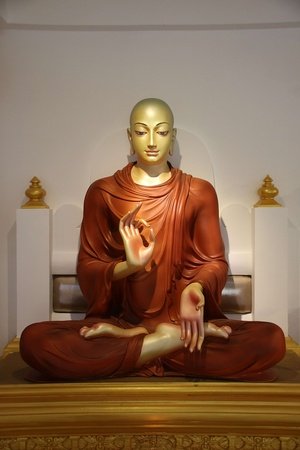
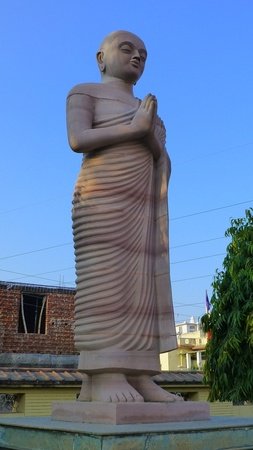
The Five Aggregates
In the Heart Sutra, it mentions repeatedly about the "five aspects of human existence". These are called the Five Aggregates (Skandha in Sanskrit or 五蘊 in Chinese), namely:
- Forms, body, or material image (rupa / 色)
- Feelings or sensations (vedana / 受)
- Perceptions (samjna / 想)
- Thought formations or mental activity (sankhara / 行)
- Consciousness (vijnana / 識)
For example, there is an apple (form) and you take a bite to taste it (feelings). You like the taste of it (perceptions) and want to take another bite (thought formations). You now learn that apple is a delicious fruit and would want to eat one next time (consciousness).
In the Heart Sutra, Avalokiteshvara told Sariputra that s/he reached the "Perfection of Wisdom" (Prajnaparamita) by realising that all these are empty (sunyata).
Emptiness
The word sunyata can be translated as empty, void or nothingness. You may think of it like the Adidas slogan "Impossible is nothing". Or more seriously, similar concept exists in Christianity, e.g.
I have seen all the works that are done under the sun; and, behold, all is vanity and a striving after wind. (Ecclesiastes 1:14)
Vanity of vanities, saith the Preacher; all is vanity. (Ecclesiastes 12:8)
So the Heart Sutra says that everything including objects, your senses (sight / sound / smell / taste / touch / thoughts), your reactions and consciousness are all empty / void / null / nothing. To reach enlightenment, one must regard these as unimportant and get rid of attachments or clinging to the five aggregates. The phrase "Form is empty, emptiness is form" is a central theory in Mahayana Buddhism that is widely known by all East Asians regardless of their religious faith, something similar to the concept that "Jesus Christ is the son of God" being known by all Christians and non-Christians.
The Twelve-fold Chain
The Heart Sutra then says that no "ignorance" and so forth until there is no "old age and death". These are the Twelve-fold Chain (or 12 nidana) in Buddhism, namely:
- Ignorance (avidya / 無明)
- Formation (sankhara / 行)
- Consciousness (vijnana / 識)
- Name and Form (namarupa / 名色)
- Six senses (salayatana / 六入)
- Contact (sparsa / 觸)
- Feeling (vedana / 受)
- Craving (tanha / 愛)
- Clinging (upadana / 取)
- Existence (bhava / 有)
- Birth (jati / 生)
- Old age and death (jaramarana / 老死)
I won't go into details of each of these, other than that one causes the next and is the reason for endless suffering, e.g. from never tasted an apple before, to loving it and wanting more. If you are interested, you can learn more in Wikipedia.
So to end the chain, one needs to end the ignorance, formation, thoughts etc. However, the Heart Sutra goes one step further. It says that ignorance is nothing, so does the pursuit of ending ignorance.
The Four Noble Truths
The Four Noble Truths (catvāri āryasatyāni) are traditionally the first teaching given by the Buddha, and considered one of the most important teachings in Buddhism. These are:
- Suffering (dukkha / 苦)
- Causes of suffering (samudaya / 集)
- End of suffering (nirodha / 滅)
- Path to the end of suffering (marga / 道)
Similar to the concept above (that both ignorance and ending ignorance are nothing), the Heart Sutra says that even the Four Noble Truths are nothing, and one has to let go of pursuing wisdom in order to attain wisdom.
The Six Realms and Nirvana
In Buddhism and other Indian religions, sentiment beings are in constant transformation (i.e. death and rebirth) within the six realms of the world, namely:
- god (devaloka / 天) - note that these are different from the God in Abrahamic religions. Although relatively happy, the god here are not free from suffering and death.
- demigod (asura / 阿修羅)
- human (manusya / 人)
- animal (tiryagyoni / 畜生)
- hungry ghost (preta / 餓鬼)
- hell (naraka / 地獄)
The Heart Sutra says that in order to attain the Perfection of Wisdom and achieve nirvana (i.e. escape from the cycle of death and rebirth within the six realms), one has to recognise that everything is empty.
The Mantra
The Heart Sutra ends with a mantra "gate gate pāragate pārasaṃgate bodhi svāhā", meaning "gone, gone, everyone gone to the other shore, awakening, svaha."
It says that this is the best of all mantras, so if you believe in this then you can start reciting it all the times!
Finally
Now you learnt the Heart Sutra, why not try my Basic Concepts of Buddhism quiz? Don't worry if you don't score well in the quiz though, after all it is nothing!

Though Buddhism originated in India, it is not very popular here. As TheNatureThread pointed out, many Indians simply consider it a form of Hinduism. Buddha is considered the ninth avatar of Vishnu, one of the Holy Trinity (trimurti) of Hinduism.